All Exams >
Electrical Engineering (EE) >
Electrical and Electronic Measurements >
All Questions
All questions of Measurement of Power & Energy for Electrical Engineering (EE) Exam
Phantom leading for testing of energy meter is used- a)for meters having fow current ratings.
- b)to reduce power loss during testing.
- c)to isolate the current and potential circuits.
- d)to test meters having a large current ratings for which loads may not be available in the laboratory. This also reduce power losses during testing.
Correct answer is option 'D'. Can you explain this answer?
Phantom leading for testing of energy meter is used
a)
for meters having fow current ratings.
b)
to reduce power loss during testing.
c)
to isolate the current and potential circuits.
d)
to test meters having a large current ratings for which loads may not be available in the laboratory. This also reduce power losses during testing.
|
|
Sharmila Kulkarni answered |
When the energy meter is tested under high current rating, there is lot of waste of power. To reduce this unwanted power loss, Phantom or Fictitious loading is done.
The declared constant of a 5 A, 220 V d.c. watthour meter is 3275 revolutions per kWh. The speed of the disc at full load is- a)8 rps
- b)3 rps
- c)1 rps
- d)2 rps
Correct answer is option 'C'. Can you explain this answer?
The declared constant of a 5 A, 220 V d.c. watthour meter is 3275 revolutions per kWh. The speed of the disc at full load is
a)
8 rps
b)
3 rps
c)
1 rps
d)
2 rps
|
|
Preethi Banerjee answered |
Here, cos φ = 1 (for d.c. watthour meter) Energy supplied to the energy meter in kWh

∴ Energy supplied to the energy meter per minute =
Given, energy meter constant, K = 3275 revolutions/kWh
∴ Disc speed in rpm = Energy supplied per minute x Energy meter constant


∴ Energy supplied to the energy meter per minute =

Given, energy meter constant, K = 3275 revolutions/kWh
∴ Disc speed in rpm = Energy supplied per minute x Energy meter constant

A wattmeter has a current coil of 0.1 Ω resistance and a pressure coil of 6500 Ω respectively. The wattmeter shows a reading of 12 A at 250 V with unity power factor. The percentage errors, due to resistance only with each of the two methods of connections shown below will be respectively- a)0.26% in connection (i) and 0.16% in connection (ii)
- b)0.32% in connection (i) and 0.48% in connection (ii)
- c)0.16% in connection (i) and 0.26% in connection (ii)
- d)0.48% in connection (i) and 0.32% in connection (a)
Correct answer is option 'D'. Can you explain this answer?
A wattmeter has a current coil of 0.1 Ω resistance and a pressure coil of 6500 Ω respectively. The wattmeter shows a reading of 12 A at 250 V with unity power factor. The percentage errors, due to resistance only with each of the two methods of connections shown below will be respectively
a)
0.26% in connection (i) and 0.16% in connection (ii)
b)
0.32% in connection (i) and 0.48% in connection (ii)
c)
0.16% in connection (i) and 0.26% in connection (ii)
d)
0.48% in connection (i) and 0.32% in connection (a)
|
|
Dipika Basak answered |
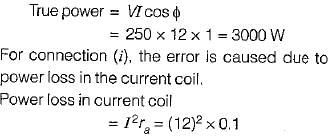
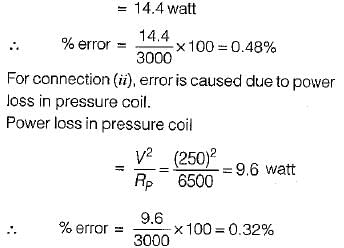
The braking torque provided by a permanent magnet in a single phase meter is proportional to the- a)square of the flux of the permanent magnet
- b)speed of the meter
- c)both (a) and (b)
- d)neither (a) nor (b)
Correct answer is option 'C'. Can you explain this answer?
The braking torque provided by a permanent magnet in a single phase meter is proportional to the
a)
square of the flux of the permanent magnet
b)
speed of the meter
c)
both (a) and (b)
d)
neither (a) nor (b)
|
|
Gargi Basak answered |
Braking torque provided by the permanent magnet is given by

Where,
N = speed of the disc in rpm
φm = maximum value of flux of the permanent magnet
d = distance of the permanent magnet from the centre of the revolving disc

Where,
N = speed of the disc in rpm
φm = maximum value of flux of the permanent magnet
d = distance of the permanent magnet from the centre of the revolving disc
Which one of the following meters is an induction type instrument?- a)Ammeter
- b)Voltmeter
- c)Energymeter
- d)Multimeter
Correct answer is option 'C'. Can you explain this answer?
Which one of the following meters is an induction type instrument?
a)
Ammeter
b)
Voltmeter
c)
Energymeter
d)
Multimeter
|
|
Saumya Basak answered |
An energymeter is an induction and an integrating type instrument.
In an induction type energy meter, an increase in temperature results in- a)a decrease in torque produced by all shading bands.
- b)a decrease in the resistance of the eddy current paths,
- c)an increase in the angle of lag ‘α’ of the eddy currents,
- d)an increase in angle of lag between V and potential coil flux φp.
Correct answer is option 'A'. Can you explain this answer?
In an induction type energy meter, an increase in temperature results in
a)
a decrease in torque produced by all shading bands.
b)
a decrease in the resistance of the eddy current paths,
c)
an increase in the angle of lag ‘α’ of the eddy currents,
d)
an increase in angle of lag between V and potential coil flux φp.
|
|
Janhavi Roy answered |
An increase in temperature is accompanied by a rise in resistance of ail copper and aluminium parts.
Assertion (A): An electrodynamometer type wattmeter reads low when the load power factor is leading.
Reason (R): The effect of pressure coil inductance is to increase the phase angle between load current and pressure coil current when the load power factor is leading.- a)Both A and R are true and R is a correct explanation of A.
- b)Both A and R are true but R is not a correct explanation of A.
- c)A is true but R is false.
- d)A is false but R is true.
Correct answer is option 'A'. Can you explain this answer?
Assertion (A): An electrodynamometer type wattmeter reads low when the load power factor is leading.
Reason (R): The effect of pressure coil inductance is to increase the phase angle between load current and pressure coil current when the load power factor is leading.
Reason (R): The effect of pressure coil inductance is to increase the phase angle between load current and pressure coil current when the load power factor is leading.
a)
Both A and R are true and R is a correct explanation of A.
b)
Both A and R are true but R is not a correct explanation of A.
c)
A is true but R is false.
d)
A is false but R is true.
|
|
Anirban Gupta answered |
Assertion (A): An electrodynamometer type wattmeter reads low when the load power factor is leading.
Reason (R): The effect of pressure coil inductance is to increase the phase angle between load current and pressure coil current when the load power factor is leading.
Explanation:
A is true because an electrodynamometer type wattmeter is designed to measure the real power in a circuit. In a circuit with a leading power factor, the wattmeter will read low due to the effect of inductive reactance in the pressure coil.
R is a correct explanation of A because when the load power factor is leading, there is a phase difference between the current flowing through the load and the current flowing through the pressure coil of the wattmeter. The inductance of the pressure coil causes a lagging current, which increases the phase angle between the load current and the pressure coil current. This leads to an error in the measurement of real power by the wattmeter.
To understand this concept more clearly, let's break down the explanation into key points:
1. Electrodynamometer Type Wattmeter:
- An electrodynamometer type wattmeter is a type of instrument used to measure the real power in a circuit.
- It works on the principle of the interaction between the magnetic field produced by the current in the pressure coil and the magnetic field produced by the current in the current coil.
2. Leading Power Factor:
- In a circuit with a leading power factor, the current leads the voltage waveform.
- This means that the current waveform reaches its peak before the voltage waveform.
3. Effect of Pressure Coil Inductance:
- The pressure coil of the electrodynamometer type wattmeter has inductance due to the presence of a coil.
- Inductance causes a phase lag between the current and voltage waveforms.
- When the load power factor is leading, the phase angle between the load current and the pressure coil current increases.
- This increased phase angle causes the wattmeter to read low.
Conclusion:
Both Assertion (A) and Reason (R) are true, and Reason (R) is a correct explanation of Assertion (A). The effect of pressure coil inductance is to increase the phase angle between load current and pressure coil current when the load power factor is leading, leading to a low reading on the electrodynamometer type wattmeter.
Reason (R): The effect of pressure coil inductance is to increase the phase angle between load current and pressure coil current when the load power factor is leading.
Explanation:
A is true because an electrodynamometer type wattmeter is designed to measure the real power in a circuit. In a circuit with a leading power factor, the wattmeter will read low due to the effect of inductive reactance in the pressure coil.
R is a correct explanation of A because when the load power factor is leading, there is a phase difference between the current flowing through the load and the current flowing through the pressure coil of the wattmeter. The inductance of the pressure coil causes a lagging current, which increases the phase angle between the load current and the pressure coil current. This leads to an error in the measurement of real power by the wattmeter.
To understand this concept more clearly, let's break down the explanation into key points:
1. Electrodynamometer Type Wattmeter:
- An electrodynamometer type wattmeter is a type of instrument used to measure the real power in a circuit.
- It works on the principle of the interaction between the magnetic field produced by the current in the pressure coil and the magnetic field produced by the current in the current coil.
2. Leading Power Factor:
- In a circuit with a leading power factor, the current leads the voltage waveform.
- This means that the current waveform reaches its peak before the voltage waveform.
3. Effect of Pressure Coil Inductance:
- The pressure coil of the electrodynamometer type wattmeter has inductance due to the presence of a coil.
- Inductance causes a phase lag between the current and voltage waveforms.
- When the load power factor is leading, the phase angle between the load current and the pressure coil current increases.
- This increased phase angle causes the wattmeter to read low.
Conclusion:
Both Assertion (A) and Reason (R) are true, and Reason (R) is a correct explanation of Assertion (A). The effect of pressure coil inductance is to increase the phase angle between load current and pressure coil current when the load power factor is leading, leading to a low reading on the electrodynamometer type wattmeter.
A dynamometer wattmeter with its voltage coil connected across the load side of the instrument reads 250 W, If the load voltage be 200 V, what power is being taken by the load?
(The voltage coil has a resistance of 2000 Ω)- a)250 W
- b)270 W
- c)230 W
- d)can’t be determined
Correct answer is option 'C'. Can you explain this answer?
A dynamometer wattmeter with its voltage coil connected across the load side of the instrument reads 250 W, If the load voltage be 200 V, what power is being taken by the load?
(The voltage coil has a resistance of 2000 Ω)
(The voltage coil has a resistance of 2000 Ω)
a)
250 W
b)
270 W
c)
230 W
d)
can’t be determined
|
|
Prisha Kulkarni answered |
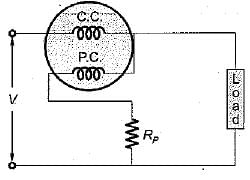
Power loss in the voltage coil =

instrument reading = 250 watt
∴ Actual load = 250 - 20
= 230 watt
A dynamometer wattmeter measures power in a 50 Hz, single phase circuit without error, at all power factors. The resistance of the voltage coil and its series resistance are 400 Ω and 10,000 Ω, respectively. The series resistance has a distributed self-capacitance equivalent to a shunt capacity of 20 pF.What is the self inductance of the pressure coil?- a)5 mH
- b)4 mH
- c)3 mH
- d)2 mH
Correct answer is option 'D'. Can you explain this answer?
A dynamometer wattmeter measures power in a 50 Hz, single phase circuit without error, at all power factors. The resistance of the voltage coil and its series resistance are 400 Ω and 10,000 Ω, respectively. The series resistance has a distributed self-capacitance equivalent to a shunt capacity of 20 pF.What is the self inductance of the pressure coil?
a)
5 mH
b)
4 mH
c)
3 mH
d)
2 mH
|
|
Swati Tiwari answered |
Given, Rp = 400Ω,
RS = 10,000 Ω
CC = 20 pF
Self inductance of the pressure coil is given by
Lp = CC x RS2
= 20 x 10-12 x (104)2
= 20 x 10-4 = 2 mH
RS = 10,000 Ω
CC = 20 pF
Self inductance of the pressure coil is given by
Lp = CC x RS2
= 20 x 10-12 x (104)2
= 20 x 10-4 = 2 mH
Two-wattmeter method is employed to measure power in a 3-phase balanced system with the current coils connected in the A and C lines. The phase sequence is ABC. If the wattmeter with its current coil in A-phase line reads zero, then the power factor of the 3-phase load will be- a)zero lagging
- b)zero leading
- c)0.5 lagging
- d)0.5 leading
Correct answer is option 'C'. Can you explain this answer?
Two-wattmeter method is employed to measure power in a 3-phase balanced system with the current coils connected in the A and C lines. The phase sequence is ABC. If the wattmeter with its current coil in A-phase line reads zero, then the power factor of the 3-phase load will be
a)
zero lagging
b)
zero leading
c)
0.5 lagging
d)
0.5 leading
|
|
Sravya Khanna answered |
When power factor = 0.5 (φ = 60°), then one wattmeter will read zero. The load will be lagging in nature.
W1 = VLIL cos (30 + φ)
and W2 = VLIL cos (30 - φ)
For φ = 60°, W1 = 0 watt
W1 = VLIL cos (30 + φ)
and W2 = VLIL cos (30 - φ)
For φ = 60°, W1 = 0 watt
In a single phase induction type energy meter, the lag adjustment is done- a)to bring the pressure coif flux in phase with the applied voltage
- b)to make the current coil flux to lag 90° behind the applied voltage
- c)to make the pressure coil flux to lag 90° behind the applied voltage
- d)none of the above
Correct answer is option 'C'. Can you explain this answer?
In a single phase induction type energy meter, the lag adjustment is done
a)
to bring the pressure coif flux in phase with the applied voltage
b)
to make the current coil flux to lag 90° behind the applied voltage
c)
to make the pressure coil flux to lag 90° behind the applied voltage
d)
none of the above
|
|
Nishtha Chauhan answered |
For the energy meter to record true energy the pressure coil should be highly inductive (i.e, Δ = 90°). Thus, for the angle between the shunt magnet flux (φρ) and the supply voltage to be 90°, a lagging coil is placed between the potential coil and the rotating aluminium disc. Lag adjustment sometimes is called power factor or quadrature or inductive load adjustment.
A 230 V, single phase, watt hour meter has a constant load of 4 A passing through it for 6 hours at unity at unity power factor. The meter disc makes 2208 revolutions during this period. If the number of revolutions made by the meter are 1472 when operating at 230 V and 5 A for 4 hours, then power factor of the load would be- a)0.6 lag
- b)0.707 lag
- c)0.866 lag
- d)0.8 lag
Correct answer is option 'D'. Can you explain this answer?
A 230 V, single phase, watt hour meter has a constant load of 4 A passing through it for 6 hours at unity at unity power factor. The meter disc makes 2208 revolutions during this period. If the number of revolutions made by the meter are 1472 when operating at 230 V and 5 A for 4 hours, then power factor of the load would be
a)
0.6 lag
b)
0.707 lag
c)
0.866 lag
d)
0.8 lag
|
|
Sanskriti Bajaj answered |
Energy supplied = VI cosφ) x t x 10-3 kWh
= 230 x 4 x 1 x 6 x 10-3
= 5.52 kWh
Energy meter constant,

Energy consumed when the meter makes 1472 revolutions

Now, energy consumed
VI cos φ x f x 10-3 kWh = 230 x 5 x cost}) x 4 x 10-3 kWh
= 3.68 kWh (As obtained above)
or,
Hence, power factor of the load = 0.8
= 230 x 4 x 1 x 6 x 10-3
= 5.52 kWh
Energy meter constant,

Energy consumed when the meter makes 1472 revolutions

Now, energy consumed
VI cos φ x f x 10-3 kWh = 230 x 5 x cost}) x 4 x 10-3 kWh
= 3.68 kWh (As obtained above)
or,

Hence, power factor of the load = 0.8
Assertion (A): A wattmeter must be used for the measurement of power in a.c. circuit instead of merely an ammeter and a voltmeter.
Reason (R): Wattmeter measures average active and reactive powers.- a)Both A and R are true and R is a correct explanation of A.
- b)Both A and R are true but R is not a correct explanation of A.
- c)A is true but R is false.
- d)A is false but R is true.
Correct answer is option 'C'. Can you explain this answer?
Assertion (A): A wattmeter must be used for the measurement of power in a.c. circuit instead of merely an ammeter and a voltmeter.
Reason (R): Wattmeter measures average active and reactive powers.
Reason (R): Wattmeter measures average active and reactive powers.
a)
Both A and R are true and R is a correct explanation of A.
b)
Both A and R are true but R is not a correct explanation of A.
c)
A is true but R is false.
d)
A is false but R is true.
|
|
Nayanika Kaur answered |
Explanation:
Assertion (A):
- A wattmeter must be used for the measurement of power in a.c. circuit instead of merely an ammeter and a voltmeter.
Reason (R):
- Wattmeter measures average active and reactive powers.
Analysis:
- The assertion is true because a wattmeter is specifically designed to measure power in alternating current circuits, taking into account both active (real) power and reactive power.
- The reason is false because a wattmeter measures only active power, not reactive power. Reactive power is measured using a separate instrument called a varmeter.
Therefore, the correct answer is:
c) A is true but R is false.
Assertion (A):
- A wattmeter must be used for the measurement of power in a.c. circuit instead of merely an ammeter and a voltmeter.
Reason (R):
- Wattmeter measures average active and reactive powers.
Analysis:
- The assertion is true because a wattmeter is specifically designed to measure power in alternating current circuits, taking into account both active (real) power and reactive power.
- The reason is false because a wattmeter measures only active power, not reactive power. Reactive power is measured using a separate instrument called a varmeter.
Therefore, the correct answer is:
c) A is true but R is false.
The error caused by pressure coil inductance in - a)capacitor across a part of series resistance in the pressure coil circuit
- b)capacitor in series with the series resistance in the pressure coil circuit
- c)capacitor across a part of a series inductor in the pressure coil circuit
- d)capacitor in series with the inductor in the pressure coil circuit
Correct answer is option 'A'. Can you explain this answer?
The error caused by pressure coil inductance in
a)
capacitor across a part of series resistance in the pressure coil circuit
b)
capacitor in series with the series resistance in the pressure coil circuit
c)
capacitor across a part of a series inductor in the pressure coil circuit
d)
capacitor in series with the inductor in the pressure coil circuit
|
|
Kunal Sharma answered |
To reduce the error in the wattmeter reading due to pressure coil inductance, the wattmeters are compensated by connecting a capacitor in parallel with a portion of series resistance (multiplier) as shown below.
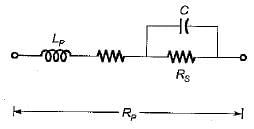

The meter constant of a 230 V, 10 A watthour meter is 1800 revolutions per kWh. The meter is tested at half load and rated voltage and unity power factor. The meter is found to make 80 rev. in 138 seconds. The meter error at half load is- a)0.817% fast
- b)0.562% slow .
- c)0.727% fast
- d)0.625% slow
Correct answer is option 'A'. Can you explain this answer?
The meter constant of a 230 V, 10 A watthour meter is 1800 revolutions per kWh. The meter is tested at half load and rated voltage and unity power factor. The meter is found to make 80 rev. in 138 seconds. The meter error at half load is
a)
0.817% fast
b)
0.562% slow .
c)
0.727% fast
d)
0.625% slow
|
|
Rithika Pillai answered |
Given, energy meter constant,
K = 1800 revolutions per kWh Actuai energy or true energy consumed by the energy meter at half load during 138 seconds is:

Also, measured energy or energy recorded is
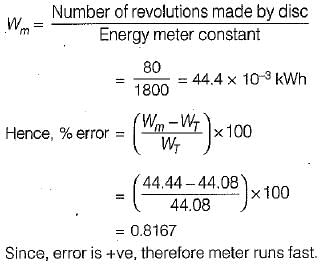
K = 1800 revolutions per kWh Actuai energy or true energy consumed by the energy meter at half load during 138 seconds is:

Also, measured energy or energy recorded is

The power factor in a 3-phase circuit using two wattmeter method is given by- a)

- b)

- c)

- d)

Correct answer is option 'A'. Can you explain this answer?
The power factor in a 3-phase circuit using two wattmeter method is given by
a)

b)

c)

d)

|
|
Sanskriti Bajaj answered |
From two-wattmeter method of measurement of power, we have:
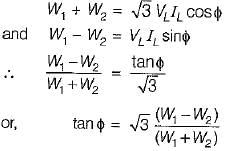
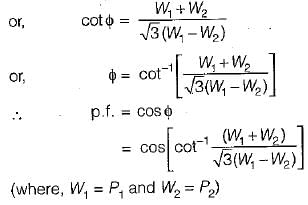


Power at RF is measured using- a)directly
- b)P = E2IR or P = I2 R
- c)wattmeter
- d)voltmeter
Correct answer is option 'B'. Can you explain this answer?
Power at RF is measured using
a)
directly
b)
P = E2IR or P = I2 R
c)
wattmeter
d)
voltmeter
|
|
Megha Datta answered |
At AF (audiofrequency) and RF (radio frequency) it is easier to measure voltage, current and impedance, than to measure- power. Direct measurement of power is not done in this range. Here, power is calculated from the equation
P = E2IR or P = I2 R
P = E2IR or P = I2 R
In an electrodynamometer type wattmeter
1. moving coil is iron cored.
2. fixed coil is air cored.
3. air friction damping is used.
4. the fixed coil is connected across the load.
5. the moving coil is connected in series with the load.Q. Which of the above statements is/are true?- a)2 and 3 only
- b)1,3,4 and 5 only
- c)2, 4 and 5 only
- d)3 and 5 only
Correct answer is option 'A'. Can you explain this answer?
In an electrodynamometer type wattmeter
1. moving coil is iron cored.
2. fixed coil is air cored.
3. air friction damping is used.
4. the fixed coil is connected across the load.
5. the moving coil is connected in series with the load.
1. moving coil is iron cored.
2. fixed coil is air cored.
3. air friction damping is used.
4. the fixed coil is connected across the load.
5. the moving coil is connected in series with the load.
Q. Which of the above statements is/are true?
a)
2 and 3 only
b)
1,3,4 and 5 only
c)
2, 4 and 5 only
d)
3 and 5 only
|
|
Nayanika Singh answered |
In an electrodynamometer type wattmeter:
• Both fixed and moving coils are air cored.
• Air friction damping is used due to low value of operating magnetic field.
• The moving coil is connected across the load.
• The fixed coil is connected is series with the load.
• Both fixed and moving coils are air cored.
• Air friction damping is used due to low value of operating magnetic field.
• The moving coil is connected across the load.
• The fixed coil is connected is series with the load.
Holes are filled on the opposite side of the disc of an induction type energy meter to- a)avoid creep on no-load
- b)balance the disc
- c)dissipate heat energy due to eddy currents
- d)increase the deflecting torque
Correct answer is option 'A'. Can you explain this answer?
Holes are filled on the opposite side of the disc of an induction type energy meter to
a)
avoid creep on no-load
b)
balance the disc
c)
dissipate heat energy due to eddy currents
d)
increase the deflecting torque
|
|
Mira Mukherjee answered |
Cripping is due to over compensation provided to the running friction. To avoid it holes are made on opposite side of the disc of the energy meter.
Assertion (A): Phantom loading of energy meter consists of supplying the fixed coil circuit from a circuit of required normal voltage, and the moving coil circuit from a separate low voltage supply.
Reason (R): When the current rating of a meter under test is high, a test with actual loading arrangement would involve a considerable waste of power due to which phantom or fictious loading is done.- a)Both A and R are true and R is a correct explanation of A.
- b)Both A and R are true but R is not a correct explanation of A.
- c)A is true but R is false.
- d)A is false but R is true.
Correct answer is option 'D'. Can you explain this answer?
Assertion (A): Phantom loading of energy meter consists of supplying the fixed coil circuit from a circuit of required normal voltage, and the moving coil circuit from a separate low voltage supply.
Reason (R): When the current rating of a meter under test is high, a test with actual loading arrangement would involve a considerable waste of power due to which phantom or fictious loading is done.
Reason (R): When the current rating of a meter under test is high, a test with actual loading arrangement would involve a considerable waste of power due to which phantom or fictious loading is done.
a)
Both A and R are true and R is a correct explanation of A.
b)
Both A and R are true but R is not a correct explanation of A.
c)
A is true but R is false.
d)
A is false but R is true.
|
|
Nandita Bajaj answered |
Phantom loading consists of supplying the pressure coil circuit (or moving coil circuit) from a circuit of required normal voltage, and the current circuit (or fixed coil circuit) from a separate low voltage supply. Hence, assertion is not true.
Reason is a correct statement.
Reason is a correct statement.
Assertion (A): For measuring the power factor of the load in case of a two-wattmeter method, load may be balanced or unbalanced.
Reason (R): For measuring the power in a three- phase circuit, load may be balanced or unbalanced, source may be balanced or unbalanced but there must be three-phase load connected to three-phase source via three- phase wires.- a)Both A and R are true and R is a correct explanation of A.
- b)Both A and R are true but R is not a correct explanation of A.
- c)A is true but R is false.
- d)A is false but R is true.
Correct answer is option 'D'. Can you explain this answer?
Assertion (A): For measuring the power factor of the load in case of a two-wattmeter method, load may be balanced or unbalanced.
Reason (R): For measuring the power in a three- phase circuit, load may be balanced or unbalanced, source may be balanced or unbalanced but there must be three-phase load connected to three-phase source via three- phase wires.
Reason (R): For measuring the power in a three- phase circuit, load may be balanced or unbalanced, source may be balanced or unbalanced but there must be three-phase load connected to three-phase source via three- phase wires.
a)
Both A and R are true and R is a correct explanation of A.
b)
Both A and R are true but R is not a correct explanation of A.
c)
A is true but R is false.
d)
A is false but R is true.
|
|
Ritika Mukherjee answered |
Measurement of power factor with the help of two-wattmeter method can be done only if load is balanced. Hence, assertion is not true. Reason is a correct statement.
Creeping in a single phase induction type energy meter may be due to- a)overvoltage
- b)vibration
- c)neither overvoltage nor vibration
- d)overvoltage or vibration
Correct answer is option 'D'. Can you explain this answer?
Creeping in a single phase induction type energy meter may be due to
a)
overvoltage
b)
vibration
c)
neither overvoltage nor vibration
d)
overvoltage or vibration
|
|
Aniket Choudhury answered |
Creeping in Single Phase Induction Type Energy Meter
Creeping in single phase induction type energy meter refers to a phenomenon where the energy meter registers more energy consumption than the actual amount of energy consumed. This happens when the energy meter disc rotates even when there is no load connected to the meter.
Causes of Creeping
There are two main causes of creeping in single phase induction type energy meter:
1. Overvoltage: When the voltage supplied to the energy meter exceeds the rated voltage, the meter disc starts rotating even when there is no load connected to it. This happens because the meter disc is designed to rotate at a particular speed corresponding to the rated voltage. When the voltage exceeds this value, the meter disc rotates faster, leading to creeping.
2. Vibration: Vibration in the energy meter can also cause creeping. This is because the meter disc is very sensitive to even small vibrations. When there is vibration in the meter, the disc starts rotating even when there is no load connected to it.
Prevention of Creeping
To prevent creeping in single phase induction type energy meter, the following measures can be taken:
1. Voltage Regulation: The voltage supplied to the energy meter should be regulated to ensure that it does not exceed the rated voltage of the meter.
2. Mounting: The energy meter should be mounted on a stable surface where there is no vibration. This will prevent any vibration from affecting the meter disc.
Conclusion
Creeping in single phase induction type energy meter is a common problem that can lead to inaccurate energy consumption readings. It can be caused by overvoltage and vibration. To prevent creeping, the voltage supplied to the meter should be regulated, and the meter should be mounted on a stable surface where there is no vibration.
Creeping in single phase induction type energy meter refers to a phenomenon where the energy meter registers more energy consumption than the actual amount of energy consumed. This happens when the energy meter disc rotates even when there is no load connected to the meter.
Causes of Creeping
There are two main causes of creeping in single phase induction type energy meter:
1. Overvoltage: When the voltage supplied to the energy meter exceeds the rated voltage, the meter disc starts rotating even when there is no load connected to it. This happens because the meter disc is designed to rotate at a particular speed corresponding to the rated voltage. When the voltage exceeds this value, the meter disc rotates faster, leading to creeping.
2. Vibration: Vibration in the energy meter can also cause creeping. This is because the meter disc is very sensitive to even small vibrations. When there is vibration in the meter, the disc starts rotating even when there is no load connected to it.
Prevention of Creeping
To prevent creeping in single phase induction type energy meter, the following measures can be taken:
1. Voltage Regulation: The voltage supplied to the energy meter should be regulated to ensure that it does not exceed the rated voltage of the meter.
2. Mounting: The energy meter should be mounted on a stable surface where there is no vibration. This will prevent any vibration from affecting the meter disc.
Conclusion
Creeping in single phase induction type energy meter is a common problem that can lead to inaccurate energy consumption readings. It can be caused by overvoltage and vibration. To prevent creeping, the voltage supplied to the meter should be regulated, and the meter should be mounted on a stable surface where there is no vibration.
Chapter doubts & questions for Measurement of Power & Energy - Electrical and Electronic Measurements 2025 is part of Electrical Engineering (EE) exam preparation. The chapters have been prepared according to the Electrical Engineering (EE) exam syllabus. The Chapter doubts & questions, notes, tests & MCQs are made for Electrical Engineering (EE) 2025 Exam. Find important definitions, questions, notes, meanings, examples, exercises, MCQs and online tests here.
Chapter doubts & questions of Measurement of Power & Energy - Electrical and Electronic Measurements in English & Hindi are available as part of Electrical Engineering (EE) exam.
Download more important topics, notes, lectures and mock test series for Electrical Engineering (EE) Exam by signing up for free.
Electrical and Electronic Measurements
48 videos|48 docs|23 tests
|

Contact Support
Our team is online on weekdays between 10 AM - 7 PM
Typical reply within 3 hours
|
Free Exam Preparation
at your Fingertips!
Access Free Study Material - Test Series, Structured Courses, Free Videos & Study Notes and Prepare for Your Exam With Ease

 Join the 10M+ students on EduRev
Join the 10M+ students on EduRev
|

|
Create your account for free
OR
Forgot Password
OR
Signup to see your scores
go up
within 7 days!
within 7 days!
Takes less than 10 seconds to signup



















